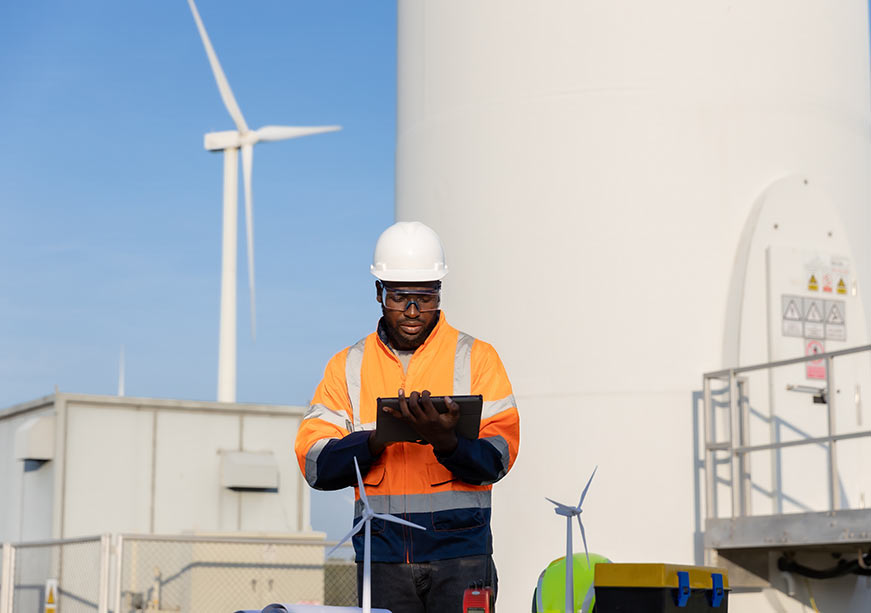-
CENTRES
Progammes & Centres
Location
Can Africa’s energy transition break the resource curse? With global aid shrinking, African leaders look to clean energy to boost growth, jobs, and autonomy

Image Source: Getty
As global geopolitical tensions rise and economic growth projections remain sluggish, cautious and thrifty governments are looking to slash external aid as the first cost-cutting measure. In response to the changing grantmaking environment, African leaders and policymakers are already carving out additional pathways for external capital mobilisation and internal revenue generation strategies. The energy transition agenda presents one such avenue for Africa to harness its core strengths—abundant resources and demographic dividend–bolstering political standing and boosting economic and social prosperity.
Africa is one of the most resource-rich countries in the world, holding 30 percent of global mineral resources, 12 percent of oil reserves, 8 percent of natural gas, 40 percent of the world’s gold and 90 percent of its chromium and platinum. It also houses the largest known reserves of cobalt, diamonds, platinum, and uranium in the world, alongside 65 percent of the world’s arable land.
Yet, despite these vast resources, some African countries struggle to translate resource wealth into widespread economic prosperity for all its citizens. This phenomenon, termed the ‘paradox of plenty’, is also called the Dutch Disease, where resource-rich countries experience slow economic growth. This often happens when natural resource exports lead to currency appreciation, which makes other sectors, such as manufacturing and agriculture, expensive and uncompetitive internationally. An overdependence on commodity revenues fosters government complacency, weakens economic diversification, and limits job creation. Extractive industries such as mining are more capital intensive than manufacturing and fail to absorb the growing workforce. Weak industrialisation induces import dependency, and local industries struggle to keep pace. Commodity markets are prone to price volatility, giving way to unfair rent-seeking and elite capture, further fueling fiscal crises and unemployment.
The investment patterns mirror this trend, with 73 percent of the FDI inflow in sub-Saharan Africa—concentrated in Nigeria, South Africa, Angola, and Ghana—in energy and extractive industries.
Africa’s trade with the rest of the world reflects such structural challenges. The continent accounts for 2 percent of global trade, while foreign direct investment (FDI) flows hover around 3.5 percent of global FDI, amounting to US$48 billion. Nearly 80 percent of Africa’s trade is in commodities, primarily minerals and fossil fuels. The investment patterns mirror this trend, with 73 percent of the FDI inflow in sub-Saharan Africa—concentrated in Nigeria, South Africa, Angola, and Ghana—in energy and extractive industries. Moreover, FDI inflows remain unevenly distributed, with 80 percent of the FDI flowing into just 15 countries.
In contrast, intra-Africa trade is more diversified, leaning towards value-added goods such as manufacturing—45 percent of total formal intra-African trade, processed food/ foodstuff—20 percent), financial, transport and banking services. In 2023, intra-Africa trade reached US$192 billion, which accounts for only 15 percent of its total trade—far below intra-trade proportions in Europe—60 percent.
Such a skewed trading relationship highlights Africa’s dependence on external markets for commodity exports and manufactured imports, reinforcing economic vulnerabilities. Although it is one of the largest crude oil producers in the world, Nigeria imports more than 80 percent of its petroleum products due to inadequate in-house refining capacity. This dynamic has been linked to a new form of neo-colonialism manifesting in economic dependency (on commodity exports and external financing) and limiting sovereign decision-making. This trend exemplifies the ”Lucas Paradox” where net capital flows ‘uphill’ from poorer to richer countries.
The continent has a unique opportunity to leapfrog to clean energy and sustainable development by harnessing its vast resources and young workforce.
In an era where supply chains are increasingly weaponised, a coordinated approach to resource governance can provide Africa with much-needed leverage, positioning it as a proactive player in the energy transition landscape. The continent has a unique opportunity to leapfrog to clean energy and sustainable development by harnessing its vast resources and young workforce. However, technology transfer and finance remain a challenge. Developing strategic partnerships and a collective roadmap to maximise their stake in their resources can reinforce Africa’s leadership in the global energy landscape.
The success of Africa’s energy transition hinges on strong industrial and energy policy making aligned with the continent’s ambitions and commitments under the African Union (AU) Agenda 2063, the Sustainable Development Goals (SDGs) and the Paris Agreement. The African Continental Free Trade Area (AfCFTA) Agreement that entered into force under AU auspices in 2019 is also crucial in this regard to mainstream and harmonise inclusive trade policies, facilitating regional industrialisation and clean energy cooperation. And most importantly, deliberate investment in education, skilling and healthcare will be crucial to unlock Africa’s vast human capital potential to support the energy transition and green growth.
This commentary originally appeared in ORF Middle East.
The views expressed above belong to the author(s). ORF research and analyses now available on Telegram! Click here to access our curated content — blogs, longforms and interviews.

Mannat Jaspal is currently serving as a Director & Fellow - Climate and Energy, at the ORF Middle East, UAE. Her research delves into the ...
Read More +